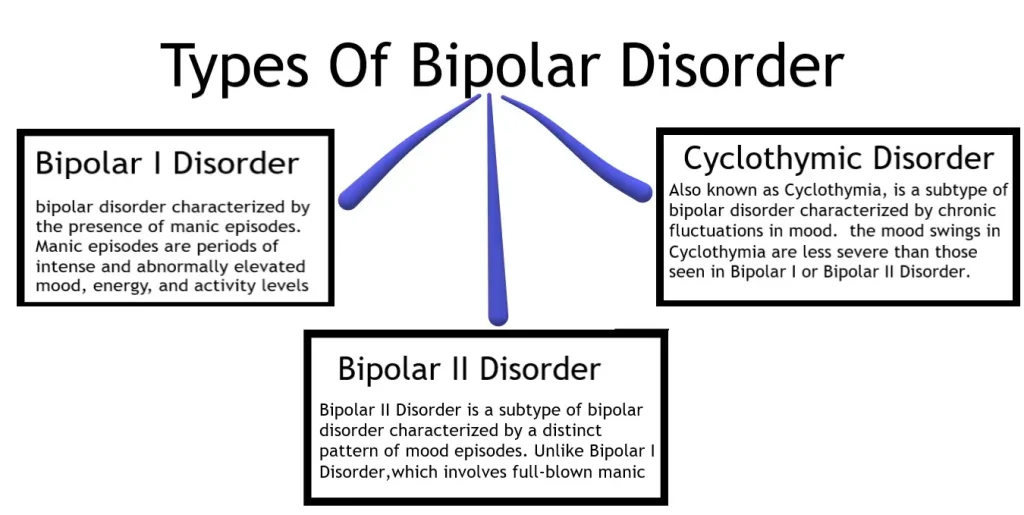Mastering the Mood Swing: Navigating Bipolar Disorder with Confidence
Bipolar Disorder is a complex mental health condition characterized by extreme mood swings that include periods of elevated mood (mania or hypomania) and periods of depression. These mood swings can vary in severity and duration, impacting a person’s ability to function in daily life. Understanding the different types, symptoms, and precautions associated with bipolar disorder is essential for effective management and support. Here’s a detailed overview:
Types of Bipolar Disorder
Bipolar I Disorder
It is a subtype of bipolar disorder characterized by the presence of manic episodes. Manic episodes are periods of intense and abnormally elevated mood, energy, and activity levels. In Bipolar I Disorder, these manic episodes typically last for at least seven days, although they can sometimes be shorter if they are severe enough to require immediate medical attention.
During a manic episode, individuals may experience a range of symptoms, including:
Elevated Mood:
Feeling euphoric, elated, or unusually happy.
Increased Energy and Activity:
Engaging in excessive goal-directed activities, such as taking on multiple projects simultaneously or working long hours without feeling tired.
Racing Thoughts:
Thoughts may feel rapid, disjointed, or uncontrollable, making it difficult to concentrate or stay focused.
Decreased Need for Sleep:
Feeling rested after only a few hours of sleep or experiencing periods of insomnia without feeling tired.
Grandiosity:
Having inflated self-esteem or feelings of superiority, often accompanied by unrealistic beliefs in one’s abilities or importance.
Impulsivity:
Engaging in risky behaviors, such as reckless driving, excessive spending, or promiscuous sexual behavior, without considering potential consequences.
It’s important to note that manic episodes in Bipolar I Disorder can be severe and may lead to significant impairment in social, occupational, or other important areas of functioning. In some cases, manic symptoms may become so severe that they require hospitalization to ensure the individual’s safety and well-being.
Additionally, depressive episodes often accompany manic episodes in Bipolar I Disorder. Depressive episodes are periods of intense sadness, hopelessness, and loss of interest or pleasure in activities that typically last for at least two weeks. During depressive episodes, individuals may experience symptoms such as low mood, fatigue, changes in appetite or weight, sleep disturbances, feelings of worthlessness or guilt, and thoughts of death or suicide.
Overall, Bipolar I Disorder is characterized by the presence of manic episodes, which are often accompanied by depressive episodes. Proper diagnosis and treatment are essential for managing symptoms and improving quality of life for individuals with this condition.
Bipolar II Disorder:
Bipolar II Disorder is a subtype of bipolar disorder characterized by a distinct pattern of mood episodes. Unlike Bipolar I Disorder, which involves full-blown manic episodes, Bipolar II Disorder involves hypomanic episodes. Hypomania is a less severe form of mania, characterized by elevated mood, increased energy, and other manic symptoms, but to a lesser extent.
Here’s a detailed explanation of Bipolar II Disorder:
Depressive Episodes:
Similar to Bipolar I Disorder, individuals with Bipolar II Disorder experience depressive episodes. These episodes are marked by persistent feelings of sadness, hopelessness, and low energy. Depressive episodes can significantly impair functioning and quality of life.
Hypomanic Episodes:
In addition to depressive episodes, individuals with Bipolar II Disorder also experience hypomanic episodes. Hypomania is characterized by symptoms similar to mania but less severe in intensity. During a hypomanic episode, individuals may feel unusually energetic, optimistic, or irritable. They may engage in goal-directed activities with increased productivity. However, unlike full-blown mania, hypomania does not cause severe impairment in functioning or require hospitalization.
Impact on Daily Life:
Although hypomania is less severe than mania, it still has a significant impact on daily life. During hypomanic episodes, individuals may have difficulty concentrating, experience racing thoughts, and engage in impulsive or risky behaviors. Despite the relative mildness of hypomania, it can still disrupt relationships, work, and other aspects of daily functioning.
Risk of Cycling:
Individuals with Bipolar II Disorder often experience rapid cycling, where they alternate between depressive and hypomanic episodes frequently. Rapid cycling can make the disorder more challenging to manage and may require adjustments to treatment strategies.
Diagnosis and Treatment:
Diagnosing Bipolar II Disorder requires a careful assessment of symptoms over time, as hypomanic episodes may be less noticeable or disruptive compared to manic episodes. Treatment typically involves a combination of medication, such as mood stabilizers or antidepressants, and psychotherapy. Psychotherapy, such as cognitive-behavioral therapy (CBT), can help individuals learn coping skills, identify triggers, and manage mood symptoms effectively.
In summary, Bipolar II Disorder involves a pattern of depressive episodes and hypomanic episodes. While hypomania is less severe than full-blown mania, it still significantly impacts daily life and requires proper diagnosis and treatment for effective management.

Cyclothymic Disorder
Cyclothymic Disorder, also known as Cyclothymia, is a subtype of bipolar disorder characterized by chronic fluctuations in mood. While the mood swings in Cyclothymia are less severe than those seen in Bipolar I or Bipolar II Disorder, they still significantly impact an individual’s daily life and functioning. Here’s a detailed explanation:
Duration and Frequency of Mood Swings
In Cyclothymic Disorder, individuals experience numerous periods of hypomanic symptoms and depressive symptoms over a prolonged period. These mood swings persist for at least two years in adults, with the duration shortened to one year in children and adolescents. Unlike Bipolar I or Bipolar II Disorder, the mood swings in Cyclothymia are not as extreme and may not meet the diagnostic criteria for a full-blown hypomanic or major depressive episode.
Hypomanic Symptoms:
During the hypomanic phases of Cyclothymic Disorder, individuals may experience symptoms similar to those seen in Bipolar II Disorder. These symptoms include elevated mood, increased energy, racing thoughts, impulsivity, and heightened creativity or productivity. However, the intensity of these symptoms is milder compared to full-blown hypomanic episodes.
Depressive Symptoms:
Similarly, during the depressive phases of Cyclothymic Disorder, individuals may experience symptoms akin to those seen in major depressive disorder. These symptoms include persistent sadness, feelings of hopelessness, fatigue, changes in appetite or weight, sleep disturbances, and difficulty concentrating or making decisions. Again, the severity of these symptoms is generally less pronounced compared to a full major depressive episode.
Impact on Functioning:
While the mood swings in Cyclothymia may be less severe than those seen in other types of bipolar disorder, they can still significantly impact an individual’s functioning and quality of life. Fluctuating between periods of elevated and depressed mood can disrupt relationships, work performance, and overall well-being.
Diagnosis and Treatment:
Diagnosing Cyclothymic Disorder requires a careful evaluation of symptoms over time. A mental health professional will assess the duration, frequency, and severity of mood swings to determine if they meet the criteria for Cyclothymia. Treatment typically involves a combination of medication, such as mood stabilizers or antidepressants, and psychotherapy. Psychotherapy can help individuals learn coping skills, develop insight into their mood patterns, and improve their ability to manage symptoms effectively.
In summary, Cyclothymic Disorder is a chronic mood disorder characterized by numerous periods of hypomanic and depressive symptoms that persist for at least two years. While the mood swings may not be as severe as those seen in other types of bipolar disorder, Cyclothymia still requires proper diagnosis and treatment to help individuals manage their symptoms and improve their quality of life.
Other Specified and Unspecified Bipolar and Related Disorders:
These categories encompass cases where symptoms do not fit the criteria for the above types but still cause significant distress or impairment in functioning.
Symptoms of Bipolar Disorder
Manic Episodes:
Here’s a detailed explanation of each symptom associated with manic episodes:
- Elevated mood or irritability: During a manic episode, individuals may experience an exaggerated sense of happiness, euphoria, or elation. They may feel unusually optimistic and confident, even in situations where such feelings are unwarranted. Alternatively, some individuals may exhibit irritability or agitation, reacting strongly to minor annoyances or frustrations.
- Increased energy, activity, and restlessness: Manic episodes are characterized by a significant increase in energy levels and physical activity. Individuals may feel a constant need to keep moving, engaging in tasks or projects with heightened enthusiasm and vigor. They may take on multiple activities simultaneously, finding it challenging to relax or sit still.
- Racing thoughts and rapid speech: Manic episodes often involve a rapid and continuous flow of thoughts, which may race through the mind at an uncontrollable pace. This rapid thought process can lead to rapid or pressured speech, where individuals talk quickly and incessantly, jumping from one topic to another without pausing for others to interject.
- Impulsive or risky behavior: One of the hallmark features of manic episodes is impulsivity, wherein individuals act on sudden urges or desires without considering the potential consequences. This may manifest as reckless behaviors such as excessive spending, gambling, substance abuse, reckless driving, or engaging in unprotected sex. The individual may disregard personal safety or financial stability during these episodes.
- Decreased need for sleep: Despite the heightened energy levels, individuals experiencing a manic episode often report a decreased need for sleep. They may feel rested and energized after only a few hours of sleep or may go for extended periods without sleeping at all. Despite the lack of sleep, they may not feel fatigued or tired, further contributing to their sense of invincibility.
- Grandiose beliefs or unrealistic confidence: In addition to an elevated mood, individuals may develop grandiose beliefs or delusions of grandeur during manic episodes. They may perceive themselves as exceptionally talented, influential, or important, believing they possess special abilities or insights that set them apart from others. This inflated sense of self-importance can lead to overestimation of one’s capabilities and unrealistic expectations of success.
Overall, manic episodes are characterized by a constellation of symptoms that collectively disrupt normal functioning and may lead to significant impairment in various aspects of life. It’s essential to recognize these symptoms early and seek professional help to manage the condition effectively. Medication, therapy, and lifestyle changes are often used in combination to stabilize mood and reduce the frequency and severity of manic episodes in individuals with bipolar disorder.
Hypomanic Episodes:
Here’s a detailed explanation of each characteristic associated with hypomanic episodes:
- Similar symptoms to manic episodes but less severe: Hypomanic episodes share many similarities with manic episodes in terms of symptoms, including elevated mood, increased energy, racing thoughts, impulsivity, and decreased need for sleep. However, the intensity and duration of these symptoms are generally less severe in hypomania compared to full-blown mania. While individuals may still experience heightened mood and energy levels, they are typically able to maintain a greater degree of control over their thoughts, behaviors, and emotions during hypomanic episodes.
- Generally do not cause significant impairment in functioning: Unlike manic episodes, which can lead to severe impairment in various areas of life, hypomanic episodes typically do not result in significant functional impairment. Individuals experiencing hypomania may still be able to fulfill their daily responsibilities, maintain social relationships, and perform adequately at work or school. While there may be some disruptions in functioning, they are often less severe and shorter in duration compared to manic episodes.
- May be perceived as periods of increased productivity or creativity: Some individuals may view hypomanic episodes as beneficial or desirable due to the perceived increase in productivity, creativity, and energy. During hypomania, individuals may feel exceptionally motivated and driven to pursue their goals, leading to heightened productivity and accomplishment. They may also experience bursts of creativity, generating new ideas, and engaging in artistic or intellectual pursuits with enthusiasm. As a result, hypomanic episodes may be perceived as periods of enhanced performance or achievement by the individual or others around them.
It’s important to note that while hypomania may not cause significant impairment in functioning, it can still have negative consequences if left untreated. Hypomanic episodes may precede or co-occur with depressive episodes in individuals with bipolar disorder, leading to rapid mood cycling and increased risk of developing more severe mood disturbances. Additionally, individuals experiencing hypomania may engage in risky or reckless behaviors that can have adverse effects on their well-being and relationships. Therefore, it’s essential to recognize the signs of hypomania and seek appropriate treatment to help stabilize mood and prevent further complications.
Depressive Episodes:
Here’s a detailed explanation of each symptom associated with depressive episodes:
- Persistent sadness or emptiness: Individuals experiencing a depressive episode often report feeling overwhelmed by an intense and pervasive sense of sadness, despair, or emotional emptiness. This feeling persists for an extended period, typically lasting for at least two weeks, and may seem disproportionate to any specific trigger or event.
- Loss of interest or pleasure in activities: A hallmark symptom of depression is the inability to experience pleasure or interest in activities that were once enjoyable or fulfilling. Hobbies, social interactions, work, and other previously engaging activities may no longer hold any appeal, leading to withdrawal and isolation.
- Changes in appetite or weight: Depression can significantly impact appetite and eating habits. Some individuals may experience a decrease in appetite, leading to weight loss, while others may experience an increase in appetite, leading to weight gain. These changes may occur rapidly or develop gradually over time.
- Sleep disturbances (insomnia or oversleeping): Sleep disturbances are common during depressive episodes and can manifest as either insomnia or hypersomnia. Insomnia involves difficulty falling asleep, staying asleep, or waking up too early and feeling unable to return to sleep. Conversely, hypersomnia involves excessive sleepiness, prolonged sleep duration, and difficulty waking up in the morning despite adequate rest.
- Fatigue or loss of energy: Individuals with depression often report feeling chronically fatigued, physically drained, or lacking in energy, regardless of the amount of sleep they get. This persistent fatigue can make even simple tasks feel overwhelming and exhausting.
- Feelings of worthlessness or guilt: Depression often involves negative self-perception and feelings of worthlessness, inadequacy, or guilt. Individuals may excessively blame themselves for perceived failures or shortcomings, even when there is no rational basis for such self-criticism.
- Difficulty concentrating or making decisions: Cognitive symptoms are common in depression and can impair attention, memory, and decision-making abilities. Individuals may struggle to concentrate on tasks, retain information, or make even simple decisions, leading to decreased productivity and performance in daily activities.
- Thoughts of death or suicide: In severe cases of depression, individuals may experience recurrent thoughts of death, dying, or suicide. They may feel hopeless, helpless, and convinced that life is not worth living. These thoughts may progress to suicidal ideation, where individuals contemplate or plan suicide as a way to escape their emotional pain.
It’s important to recognize that not everyone with depression will experience all of these symptoms, and the severity and duration of symptoms can vary widely among individuals. However, the presence of several of these symptoms persisting for an extended period is indicative of a depressive episode and warrants professional evaluation and treatment. Prompt intervention, including therapy, medication, and support from loved ones, can help individuals manage their symptoms and improve their quality of life. If you or someone you know is experiencing thoughts of suicide or self-harm, it’s crucial to seek immediate help from a mental health professional or emergency services.
Precautions for Bipolar Disorder:
- Seek Professional Help: If you suspect you or someone you know may have bipolar disorder, it’s essential to seek evaluation and treatment from a mental health professional. Early diagnosis and intervention can lead to better outcomes.
- Medication Management: Medications such as mood stabilizers, antipsychotics, and antidepressants may be prescribed to help manage symptoms. It’s crucial to take medications as prescribed and communicate any concerns or side effects with your healthcare provider.
- Psychotherapy: Therapy, such as cognitive-behavioral therapy (CBT) or interpersonal therapy, can help individuals learn coping skills, identify triggers, and manage symptoms effectively.
- Regular Monitoring: Regular check-ins with a mental health professional can help monitor symptoms, adjust treatment as needed, and prevent relapses.
- Lifestyle Management: Healthy lifestyle habits, including regular exercise, balanced nutrition, adequate sleep, stress management techniques, and avoiding alcohol and drugs, can help stabilize mood and support overall well-being.
- Social Support: Building a strong support network of family, friends, and support groups can provide emotional support, understanding, and encouragement during challenging times.
- Awareness of Triggers: Identifying and avoiding triggers such as stress, sleep disturbances, and substance use can help prevent mood episodes.
- Safety Planning: Developing a safety plan that includes strategies for managing suicidal thoughts or behaviors is crucial, especially during depressive episodes.
Conclusion
In conclusion, bipolar disorder is a complex mental health condition that requires comprehensive management and support. By understanding the types, symptoms, and precautions associated with bipolar disorder, individuals and their loved ones can work together to effectively manage symptoms, improve quality of life, and promote overall well-being.




